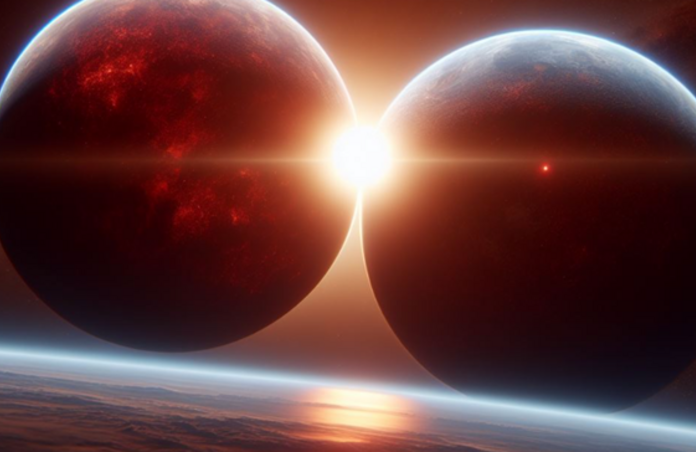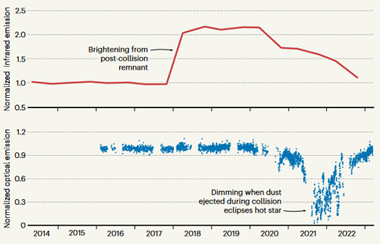Discovery of the First Exoplanetary Collision

Exoplanets have long been a subject of fascination and intense study in astronomy. These distant worlds, discovered in a variety of sizes and orbital environments, offer a window into the diversity and complexity of planetary systems in our galaxy. These must often be explored during transit of their hosts, as light from this star is absorbed by an orbiting exoplanet passing in between our line of sight. This approach can lead to the discovery of more dramatic observations for instance, planetary collisions. Such an event would result in the formation of a debris disk. Studying this disk can provide valuable insights into the processes shaping planet formation and the dynamic events shaping their early evolution.
The first such event is discussed in a recent paper, by Matthew Kenworthy et al, involving the star 2MASS J08152329-3859234, now known as ASASSN-21qj. The target is a G2-type dwarf star, discovered as part of the All-Sky Automated Survey for Supernovae (ASASSN). It has become the focus of astrophysical investigation following a sudden optical eclipse in December of 2021, two and a half years after an infrared brightening. The group leveraged light curves gathered in 2021 by the Large Atacama Millimetre Array (ALMA), in an attempt to rationalise these phenomena.

Analysis of the situation began with the above light curves, investigating their structure and origin. Based on the duration of the eclipse, estimated to be ~500 days, the team conclude that this corresponds to a vast amount of occulting debris in orbit around the star. The gradient of the dimming and subsequent brightening of the star imply that this debris has lower limit for transverse orbital velocity of 7.5 kms-1. This happens to correlate strongly with their models of a planetary collision, on the order of 10 M⊕.
Additionally, they note that the optical colour of the star varied during the eclipse, explaining that this wavelength dependent absorption is atypical in most planetary disks. This was a by-product of the unusual spatial and size distribution of the dust particles. A planetary collision would lead to a wide distribution in the size of post-collision fragments. This further results in the gravitational clumping of smaller particles to larger ones. This uneven distribution of absorbers would lead to the observed temporal colour variation.
Finally, the team return to the infrared light curve to investigate the cooling of this system. As mentioned, their models posit that the initial flash is the thermal emission of debris, heated up during the collision. The team modelled how the debris following such an event would cool and over what time period cooling would be typical. Again, their results were found to be consistent with the actual cooling of ASASSN-21qj.
The paper discusses two other potential explanations. The first is that these two events are coincidental and entirely uncorrelated. The second posits that a debris disk may already have been present, orbiting at ~1 AU, which could be responsible for both events. However, they do not neglect to emphasise that their results strongly correlate with a planetary collision model.
The study by Matthew Kenworthy et al. on the peculiar optical eclipse of star ASASSN-21qj suggests compelling evidence of a planetary collision. The observed long-duration eclipse, unique colour variations during the event, and corresponding cooling patterns align with their collision model. The lead authors now call for further investigation into the post-collision ejecta as this event provides a powerful case study for our yet incomplete understanding of early solar system evolution.
--
Journal Source: M. Kenworthy et al, A planetary collision afterglow and transit of the resultant debris cloud, Nature Astronomy, Vol. 622, Pg 251-254, https://doi.org/10.1038/s41586-023-06573-9, 2023
Cover Image: DALL-E 3, Microsoft Bing Image Creator, prompt
